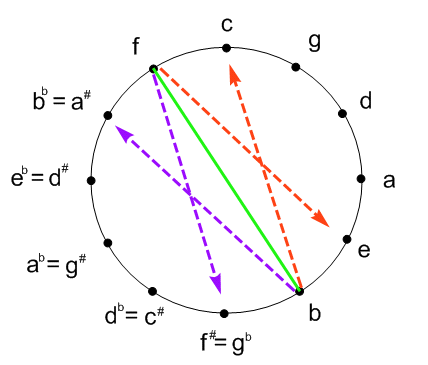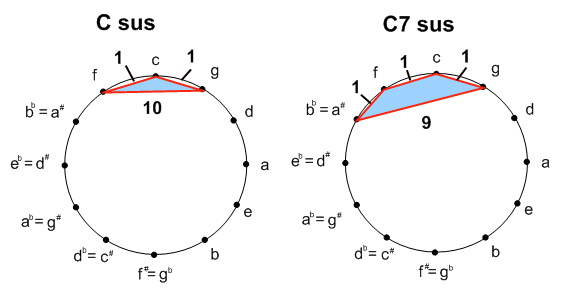
In the process of teaching myself music theory, I have become very impressed with
the power of the Circle of 5ths (here I am talking about the standard circle in 12-equal
temperament). I have cataloged some interesting properties, and I am always on the
lookout for more.











| Roman number | Notes | Chord name | Chord name | Notes | Roman number |
|---|---|---|---|---|---|
| I | c-e-g | C | Cm | g-eb-c | i |
| ii | d-f-a | Dm | Bb | f-b |
VII |
| iii | e-g-b | Em | Ab | eb-c-ab | VI |
| IV | f-a-c | F | Gm | d-bb-g | v |
| V | g-b-d | G | Fm | c-ab-f | iv |
| vi | a-c-e | Am | Eb | bb-g-eb | III |
| viio | b-d-f | B dim | D dim | ab-f-d | iio |
Why does any major triad always reflect to a minor triad? It is enough to show this for C major, since we can rotate to any other major chord. From the root note c, the 5th is 1 step clockwise (we always measure distances clockwise, so from now on I'll just say the distance is "+1 steps") and the major 3rd is +4 steps and the minor 3rd is -3 steps. From rotational symmetry, this is true for all the chords.
Now we make an arbitrary reflection of the circle, and so c is mapped to c', and likewise e → e', and g → g'. We have to show that this new triad is a minor chord. c' and g' are still adjacent to each other, since reflections can't change distances, but now g' is -1 steps from c', so g' is the root and c' is the 5th. Since in fact all intervals are reversed in reflections (we'll prove this at the end), the distance from c to e is +4 and thus the distance from c' to e' is -4. This means that the distance from g' to e' is -3 and we have all the intervals for a minor chord.
Lemma: In any reflection, the direction of any interval is reversed.If a point x on the circle is counter clockwise from a point y then the distance (measured clockwise) satisfies d(p,x) < d(p,y) for any p on circle. Let L be an arbitrary line of reflection and p any one of the 2 points when L meets the circle (just choose one and forget the other). A reflection through L is the same thing as taking a point x that is +n units from p and sending it to z' which is -n units from p. Thus under a reflection, if d(p,x) = n and d(p,y) = m with n < m, we get d(p,x') = -n and d(p,y') = -m and obviously -n > -m so the interval is reversed. ♠

Here symmetry plays a big role also. We have already remarked on the symmetry between major and minor chords. Here we observe that symmetry within a chord makes it ambiguous as to what key it belongs to.



Cm6 is an "inverse" of the resolvent C7F (swap the 2 and 3 length
segments, not the tri-tone line).


Also exhibited here is C diminished 6th, which is extremely symmetrical, and therefore,
key ambiguous (we could just as easily name it as A dim 6, F# dim 6
or Eb dim 6). It can be thought of as Cdim + F#dim or
Ebdim + A dim. It is very interesting to look at it
outside 12-equal where it loses its symmetry!


I got the idea for drawing chords in the circle of fifths from Harmony and Ear Training at the Keyboard by Stanley N. Shumway. In Appendix 1 Symmetrical Sonorities he features many different diagrams than found here such as modes, whole tone scales, etc. (and many diagrams found here are not in Shumway's text).
Musical-U is a company that has an interesting discussion of How To Use The Circle Of Fifths . They also present many other topics related to music and have study courses available.
Return to Music Theory
Return to Home Page
Send me email:
jjensen14@hotmail.com Advisory: messages
with keywords typical of spam in the subject line (including "!" as in "Get out of
debt!") get automatically discarded before I see them.